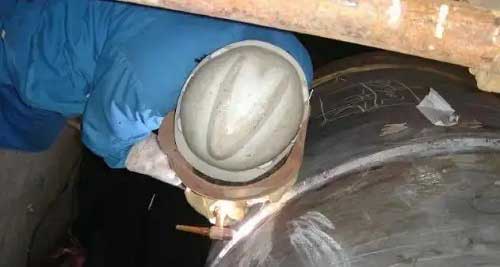Welding of steel to nickel and nickel alloys (Tech Center of Shanghai HY Industry Co., Ltd)
In the manufacture of chemical and petroleum equipment, it is often necessary to weld steel with nickel and alloys in order to save expensive nickel.
The main problem with welding
 During welding, the main components in the weld are iron and nickel, which are infinitely soluble in each other and do not form intermetallic compounds. In general, the nickel content in the weld is relatively high, so no diffusion layer will form in the fusion zone of the welded joint. The main problem with welding is the tendency to create pores and hot cracks in the weld.
During welding, the main components in the weld are iron and nickel, which are infinitely soluble in each other and do not form intermetallic compounds. In general, the nickel content in the weld is relatively high, so no diffusion layer will form in the fusion zone of the welded joint. The main problem with welding is the tendency to create pores and hot cracks in the weld.
1. Stomata
When steel is welded with nickel and its alloys, the main factors affecting the formation of pores in the weld are the contents of oxygen, nickel and other alloying elements.
-
The influence of oxygen. During welding, more oxygen may be dissolved in the liquid metal, and oxygen oxidizes with nickel at high temperature to form NiO. NiO can react with hydrogen and carbon in the liquid metal to generate water vapor and carbon monoxide. When the molten pool solidifies, such as There is no time to escape, and the remaining in the weld will form pores. In the iron-nickel weld of pure nickel and Q235-A submerged arc welding, the higher the oxygen content in the weld, the greater the number of pores in the weld under the condition that the nitrogen and hydrogen content does not change much.
-
Influence of nickel. In iron-nickel welds, the solubility of oxygen in iron and nickel is different. The solubility of oxygen in liquid nickel is greater than that in liquid iron, while the solubility of oxygen in solid nickel is smaller than that in solid iron. Therefore, oxygen The sudden change in the solubility of nickel is more obvious than the sudden change in iron crystallization. Therefore, when the Ni content in the weld is 15%~30%, the porosity tendency is small, and when the Ni content is large, the porosity tendency is further increased to 60%~90%, and the amount of molten steel will inevitably decrease, so the tendency to form porosity changes. big.
-
Influence of other alloying elements. When the iron-nickel weld contains manganese, chromium, molybdenum, aluminum, titanium and other alloying elements or conforms to alloying, the porosity resistance of the weld can be improved. This is because manganese, titanium and aluminum have deoxidation effects, while chromium and Molybdenum increases the solubility in the solid metal of the weld. Therefore, the porosity resistance of nickel and 1Cr18Ni9Ti stainless steel welds is higher than that of nickel and Q235-A steel welds. Aluminum and titanium also fix nitrogen in a stable compound and also improve the weld resistance to porosity.
2. Hot crack
-
In the weld of steel and nickel and its alloys, the main reason for hot cracks is that due to the high nickel weld with dendritic structure, some low-melting eutectic crystals are concentrated on the edges of the coarse grains, thereby weakening the grains. The connection between them reduces the crack resistance of the weld metal. In addition, the excessively high nickel content of the weld metal has a significant impact on the hot cracking of the weld metal. In the iron-nickel weld, impurities such as oxygen, sulfur, and phosphorus also have a great influence on the hot cracking tendency of the weld.
-
When oxygen-free flux is used, the amount of cracks is greatly reduced due to the reduction in the quality of harmful impurities such as oxygen, sulfur, and phosphorus in the weld, especially the decrease in oxygen content. Because when the molten pool crystallizes, oxygen and nickel can form Ni+NiO eutectic, the eutectic temperature is 1438 ℃, and oxygen can also strengthen the harmful effect of sulfur. Therefore, when the oxygen content in the weld is high, the tendency of hot cracking is large.
-
Alloying elements such as Mn, Cr, Mo, Ti, Nb can improve the crack resistance of the weld metal. Mn, Cr, Mo, Ti, and Nb are all modifiers, which can refine the weld structure and disrupt its crystallographic direction. Al and Ti are also strong deoxidizers, which can reduce the oxygen content in the weld. Mn can form the refractory compound MnS with S, thereby reducing the harmful effects of sulfur.
Mechanical properties of welded joints
-
The mechanical properties of iron-nickel welded joints are related to filler metal materials and welding parameters. When welding pure nickel and low carbon steel, when the Ni equivalent in the weld is less than 30%, under the condition of rapid cooling of the weld, a martensitic structure will appear in the weld, resulting in a sharp decrease in the ductility and toughness of the joint. Therefore, in order to obtain better plasticity and toughness of the joint, the Ni equivalent in the iron-nickel weld should be greater than 30%.

